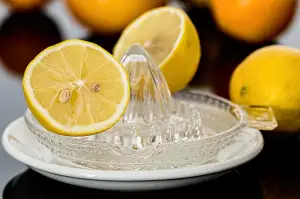DIY Fruit Fly Trap: Your Ultimate Guide to Banishing Pesky Flies at Home

Fruit flies are a common nuisance in many homes, especially during the warmer months. These tiny insects are attracted to ripe fruits and vegetables, as well as sugary substances like juice and wine. While they may seem harmless, fruit flies can quickly multiply and become a major annoyance. They can contaminate food with bacteria and spoilage organisms, making it essential to address the problem promptly. In this article, we will explore the ultimate guide to banishing these pesky flies from your home using a DIY fruit fly trap.
Importance of using a fruit fly trap
The importance of using a fruit fly trap cannot be overstated. Fruit flies are not only annoying, but they can also contaminate our food and spread bacteria. By using a fruit fly trap, we can effectively control their population and prevent them from infesting our homes. A fruit fly trap acts as a lure, attracting the flies and trapping them inside, thus reducing their numbers significantly. It is an essential tool in maintaining a clean and hygienic environment in our kitchens and living spaces.
Materials needed for a DIY fruit fly trap
To create your own DIY fruit fly trap, you will need a few simple materials that are commonly found in most households. Here's a list of what you'll need:
1. A small glass or plastic container with a lid: This will serve as the main body of the trap and should be able to hold the attractant and trap the flies inside.
2. Apple cider vinegar: Fruit flies are attracted to the sweet smell of fermented fruits, making apple cider vinegar an excellent bait for them.
3. Dish soap: Adding a few drops of dish soap to the mixture helps break the surface tension of the liquid, causing the flies to sink and drown.
4. Plastic wrap or cling film: This will be used to cover the container and create a small opening for the fruit flies to enter.
5. Rubber band or tape: To secure the plastic wrap in place and prevent any escapes.
These materials are easy to find and affordable, making it convenient for anyone looking to tackle their fruit fly problem at home. With these items ready, you can proceed to follow our step-by-step instructions for making an effective DIY fruit fly trap.
Step-by-step instructions for making a fruit fly trap
Step 4: Step-by-step instructions for making a fruit fly trap
Making your own fruit fly trap is simple and cost-effective. Follow these easy steps to create an effective trap:
1. Gather the materials: You will need a small glass or jar, apple cider vinegar, dish soap, plastic wrap, and a rubber band.
2. Pour apple cider vinegar into the glass or jar until it fills about 1/4 of the container.
3. Add a few drops of dish soap to the vinegar. The soap will break the surface tension, causing the flies to sink when they come in contact with it.
4. Cover the top of the glass or jar with plastic wrap, making sure it is tightly secured with a rubber band.
5. Use a toothpick or fork to poke several small holes in the plastic wrap. These holes will allow the flies to enter but make it difficult for them to escape.
6. Place the trap near areas where you have noticed fruit flies, such as near ripe fruits or trash cans.
7. Wait for a few hours and check on your trap. You should start seeing fruit flies trapped inside.
Remember to replace the mixture every few days or when it becomes full of flies.
By following these steps, you can easily create an effective fruit fly trap using common household items.
Tips for effective placement of the trap
When it comes to effectively placing your DIY fruit fly trap, there are a few key tips to keep in mind. First and foremost, it's important to place the trap near the source of the fruit flies. This could be a bowl of overripe fruit, a compost bin, or even a garbage can.
Additionally, make sure to place the trap in an area where it won't be disturbed or knocked over. Fruit flies are attracted to the scent of rotting fruit, so keeping the trap close to their food source will increase its effectiveness.
Another tip is to place multiple traps throughout your home. Fruit flies can quickly multiply and infest various areas, so having multiple traps will help capture them more efficiently.
Lastly, consider placing the trap in areas with high foot traffic or where you've noticed an abundance of fruit flies. This could be near windows, doors, or even on countertops.
By following these placement tips, you'll maximize the effectiveness of your DIY fruit fly trap and reduce pesky fly populations in your home.
Natural remedies to prevent fruit fly infestation
One of the best ways to prevent fruit fly infestation is by using natural remedies. These remedies not only help in repelling fruit flies but also ensure a safe and chemical-free environment in your home.
1. Keep your kitchen clean: Fruit flies are attracted to ripe or decaying fruits and vegetables, as well as spills and crumbs. Regularly clean your kitchen countertops, wash dishes promptly, and dispose of any overripe produce.
2. Store fruits and vegetables properly: Keep your fruits and vegetables in the refrigerator or in sealed containers to prevent them from ripening too quickly and attracting fruit flies.
3. Use vinegar traps: Fruit flies are attracted to the smell of vinegar. Fill a small bowl with apple cider vinegar or red wine vinegar, cover it with plastic wrap, and poke a few holes in it. The flies will be lured by the scent, enter through the holes, but won't be able to escape.
4. Employ essential oils: Certain essential oils like lemongrass, lavender, eucalyptus, or peppermint can repel fruit flies. Mix a few drops of these oils with water in a spray bottle and spritz it around areas prone to infestation.
5. Create a DIY fly repellent spray: Make a solution by mixing equal parts water and white vinegar along with a few drops of dish soap. Spray this mixture on surfaces where fruit flies tend to gather.
By incorporating these natural remedies into your routine, you can effectively prevent fruit fly infestations without resorting to harmful chemicals or pesticides.
Maintenance and cleaning of the fruit fly trap
Maintenance and cleaning of the fruit fly trap is essential to ensure its effectiveness in banishing pesky flies. Regularly check the trap for any trapped flies and dispose of them properly. Empty the liquid solution and rinse the trap with warm soapy water to remove any residue or debris. Scrub the trap gently with a brush if necessary. Refill the trap with fresh bait and solution regularly to attract more fruit flies. Remember to clean the surrounding area as well, as leftover fruits or spills can attract new flies. By maintaining and cleaning your DIY fruit fly trap, you can keep your home free from these annoying pests.
In conclusion, DIY fruit fly traps are a simple and effective solution to banishing those pesky flies from your home. By using readily available materials and following the step-by-step instructions, you can create a trap that will help eliminate fruit fly infestations. Remember to place the trap in strategic locations and consider natural remedies to prevent future infestations. Regular maintenance and cleaning of the trap will ensure its effectiveness. Say goodbye to fruit flies and enjoy a fly-free environment in your home!
Published: 11. 12. 2023
Category: Home



